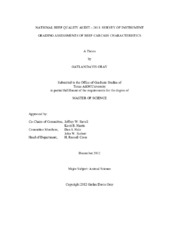| dc.description.abstract | The instrument grading assessments for the NBQA-2011 evaluated seasonal trends of beef carcass quality and yield attributes over the course of the year. One week of instrument grading data—HCW, gender, USDA QG, and YG factors—were collected every other month (n = 2,427,074 carcasses) over a 13-month period (November 2010 through November 2011) from four beef processing corporations, encompassing 17 federally inspected beef processing facilities, to create an overview of carcass quality and yield attributes and trends from carcasses representing approximately 8.5% of the U.S. fed steer and heifer population. Mean yield traits were: YG (2.86), HCW (371.3 kg), FT (1.19 cm.), and LM area (88.39 cm^2). The YG distribution was YG 1 (15.7%), YG 2 (41.0%), YG 3 (33.8%), YG 4 (8.5%), and YG 5 (0.9%). Distribution of HCW was <272.2 kg (1.6%), 272.2 kg to 453.6 kg (95.1%), ≥453.6 kg (3.3%). Monthly HCW means were: November 2010 (381.3 kg), January 2011 (375.9 kg), March 2011 (366.2 kg), May 2011 (357.9 kg), July 2011 (372.54 kg), September 2011 (376.1 kg), and November 2011 (373.5 kg). The mean FT for each month was November 2010 (1.30 cm), January 2011 (1.22 cm), March 2011 (1.17 cm), May 2011 (1.12 cm), July 2011 (1.19 cm), September 2011 (1.22 cm), and November 2011 (1.22 cm). The mean marbling score was Small49. USDA QG distribution was Prime (2.7%), Top Choice (22.9%), Commodity Choice (38.6%), and Select (31.5%). Interestingly, from November to May, seasonal decreases (P < 0.001) in HCW and FT were accompanied by increases (P < 0.001) in marbling. These data present the opportunity to further investigate the entire array of factors that determine the value of beef. Datasets utilizing the online collection of electronic data will likely be more commonly used when evaluating the U.S. fed steer and heifer population in future studies. These data indicate the wide array of carcasses produced by the beef cattle industry, and how the frequency of both YG and QG traits change from month-to-month. | en |


